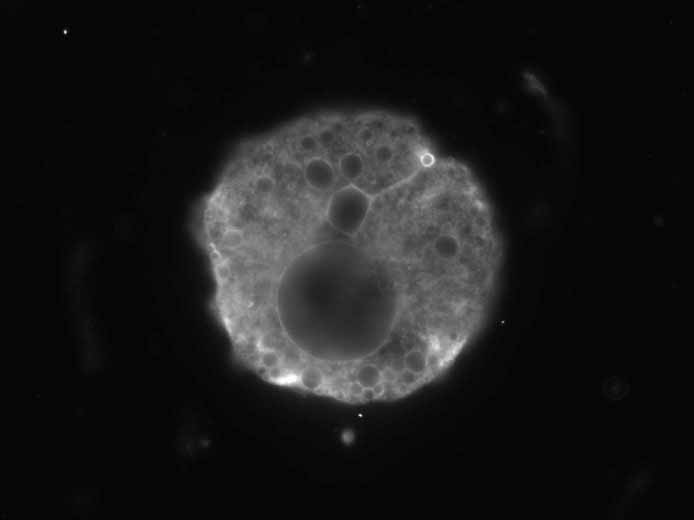Cells are the smallest basic unit of life. They are made up of millions of molecules and are composed of all 4 macromolecules: lipids, nucleic acids, proteins, and, yes, even carbohydrates. As a former cell biologist, my absolute, hands-down, most favorite part of being a scientist was spending hours and hours in front of the fluorescent microscope, examining the inside of the cell like a miniature spaceship navigating through the cell like a galaxy (see Isaac Asimov's Fantastic Voyage, a class sci-fi fantasy about miniature dudes who explore the human body in a miniature spaceship).

A picture of an adipocyte (a fat cell), which I took as a graduate student.
There are many different types of cells. Cells can exist as a single-celled organism (bacteria, algae, Amoebas, etc). They can exist cooperatively, making up multi-celled organisms, from snails, to birds, and of course, humans. Cells come in all different shapes and sizes. Some have cell walls, some don't. Some move around a lot; others remain motionless their whole lives. Each cell has a special function so each cell is designed a little differently. They are specialized, or physically customized according to that cell's main function. For instance, skin cells contain a lot of keratin, the structural protein that makes our skin a protective barrier and helps make our nails hard. Red blood cells are specially designed to transport oxygen and deliver it to all parts of the body. They don't even have a nuclei, which is why they are sometimes called ghosts.
Cells have always fascinated me. The intricate design of a cell is like a perfectly tuned orchestra.
Animal Cell
Plant Cell
Bacteria Cell (note: this is a prokaryote. The above 2 are eukaryotes).
Video About the ATP cycle:
Link to Running & ATP:
http://runningtimes.com/Article.aspx?ArticleID=7792&PageNum=&CategoryID
Link to Video (on my home page):
White blood cell chasing a bacterial cell (red blood cells also shown). Great for illustrating how dynamic cells are, the differences between prokaryotes and eukaryotes and cell specialization.
Link to video
Chloroplasts:
Link to my Resources (Google Docs Folder):
https://docs.google.com/folder/d/0BxAJgJ5OqE-GQkRKVllVOXJKTkE/edit
Go here for lesson plans, ideas, and activities!
Outside links to other resources on cells:
Great ideas for a myriad of a areas related to biology from Serendip
Photosynthesis:
Role-play Photosynthesis Activity
Video clips:
Great clip from NASA on the role of phytoplankton and the ocean
Thank you for this!!! I teach special education. Which covers a wide variety of learning styles. This was explained simply and with a lot of visuals. These kids are amazing, but they need more people who can translate what seems impossible. I look forward to looking at all the different links on your site.
ReplyDelete